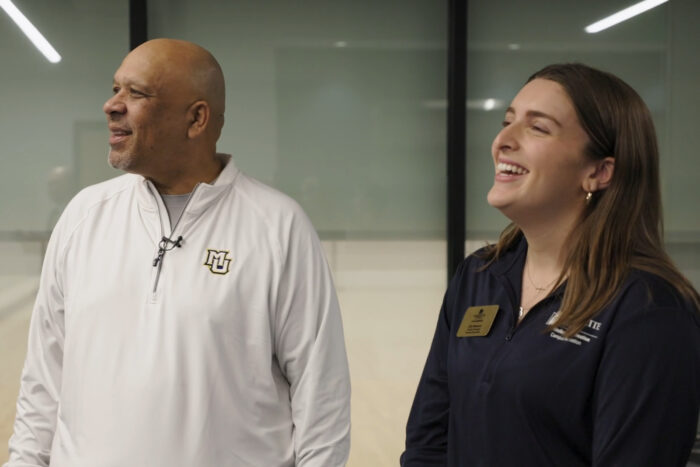The disease poses serious challenges for young people as they transition from pediatric to adult care, so Dr. Dora Clayton-Jones’ groundbreaking project will examine how to best support them.
By Stephen Filmanowicz with Lauren Sieben

Dr. Dora Clayton-Jones was a primary care nurse at Children’s Hospital of Wisconsin in the early 1990s when she first started caring for young people living with sickle cell disease. From these young patients, she came to understand the pain and fatigue they felt much of the time, side effects of a genetic condition that causes the red blood cells in their arteries and veins to distort into a sickle or banana shape after delivering their loads of oxygen, rather than stay round. And she saw how this condition inevitably leads to crises as these narrow, sticky red cells clump together and clog blood vessels, bringing debilitating pain and serious risk of tissue death and organ damage.

In the intervening years, Clayton-Jones, Grad ’99, ’14, has worked as a pediatric nurse practitioner in urgent care and school-based settings and made sickle cell disease care the subject of her doctoral dissertation and subsequent research as an assistant professor of nursing. Now in her third year as president of the International Association of Sickle Cell Nurses and Professional Associates, she’s a national expert on sickle cell care with an intimate knowledge of the needs of those living with the disease, about 85 percent of whom are Black.
This perspective has helped Clayton-Jones zero in on a high-risk population that will benefit from customized support — young adults transitioning from pediatric to adult care. “We often see — and research provides statistics on this — that when adolescents experience this transition, their mortality rate increases,” she says. “Helping these young people increase their capacity to care for themselves, for self-management, certainly does contribute to lower mortality rates.”


What’s needed, Clayton-Jones says, is a comprehensive approach supporting these young adults in everything from monitoring their symptoms to navigating challenges such as school or work absences that become unavoidable when crises arise. As one of 10 recipients of the 2021 Betty Irene Moore Fellowship for Nurse Leaders and Innovators from the University of California, Davis, Clayton-Jones is piloting an effort to provide that support. With $450,000 from the foundation, she has launched a community-engaged research project, Eliminating Sickle Cell Disparities Among Youth: The POSSE Project. Its centerpiece will be an intensive one-week residential program on Marquette’s campus this summer for Milwaukee-area 18- to 19-year-olds with sickle cell disease.
In the summer program, Clayton-Jones and her team will reinforce important concepts in self-management such as recognizing — and reducing — stressors that can initiate a sickle cell crisis. “Mental or emotional stress is a common trigger. Being in the cold can be a trigger. A pool can be too cold, so going swimming can lead to a crisis,” she says.
Physical stressors can be triggers too, including contagious illnesses that tax the body. “COVID-19 can create special problems. The complications it causes can be more aggravated for people living with sickle cell disease,” Clayton-Jones says. “When we talk about at-risk individuals who are living with chronic illness during COVID, we usually hear about people with diabetes or people with a history of heart problems. It’s important that people with sickle cell disease aren’t left out of the narrative.”

Monitoring symptoms and managing pain are also key for those living with the disease. “It’s really important that they are promptly treated for pain. They generally have medications they can use at home. And then, when pain can’t be managed at home, it’s important that they seek care. It’s an emergency.”
Informed by Clayton-Jones’ longtime commitment to listening to her patients and conducting community-engaged research, the programming for the week will go far beyond managing the disease itself. Participants will learn how to advocate for themselves in the health care system and how to find vocational opportunities.
Healthy lifestyles and physical activity will be covered as well, even though exercise was once considered too risky for people living with the disease. In recent years, sickle cell scientists, including Dr. Robert Liem, section head of hematology at Lurie Children’s Hospital of Chicago, have looked at the safety of exercise at moderate to intense levels in those living with sickle cell disease, Clayton-Jones says. “Today, we are talking about how to exercise safely,” she adds. “So, we are having as a virtual guest, Dr. Foluso Joy Ogunsile, an assistant professor at the University of Alabama-Birmingham, whose area of research is exercise and all of the components that go along with that for sickle cell patients.”
Since her early days in graduate school, Clayton-Jones has been painfully aware of the resource — and research — disparities that impair outcomes for sickle cell patients. “When I looked at the literature back then, there was no comparison,” she says. “Other populations are more highly funded in comparison to the sickle cell population.”
That’s why she recognized the Betty Irene Moore Fellowship, with its commitment to addressing health disparities and its focus on mentoring and advising researchers, as an excellent match for her. Learning of the award, “I screamed,” she says, “just thinking how much this could support the sickle cell community. I was beyond grateful and overjoyed.”



